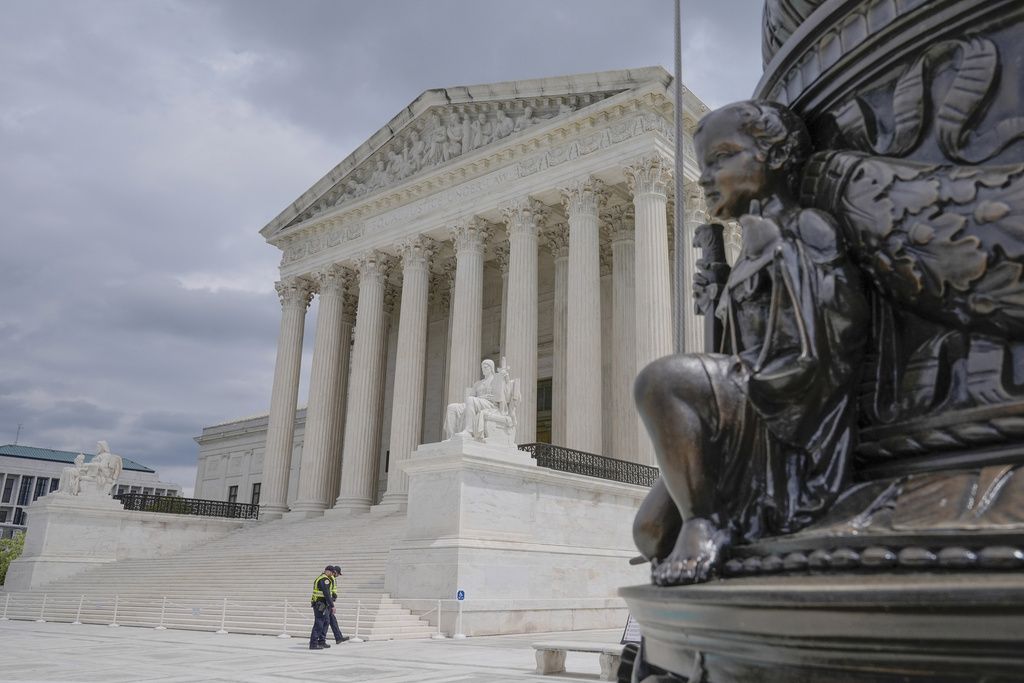

President-elect Donald Trump’s victory signals the potential for major shifts in court battles over Biden administration policies, covering areas such as transgender procedures for minors, immigration, environmental rules, and gun control.
The most visible impact may occur at the Supreme Court, where the Biden administration is currently defending its stance on several high-stakes issues. Trump’s administration could attempt to adjust positions in numerous cases currently pending in the federal court system, realigning legal strategies to fit his policy preferences or even seeking to dismiss certain cases.
Case Western Reserve University law professor Jonathan Entin told the Washington Examiner that completely tossing existing cases that have already spent months before the Supreme Court or a lower federal court can be challenging. Entin said that if a legal challenge targets an agency regulation, the DOJ might want to weigh its options regarding handling existing lawsuits.
That could involve the Trump administration alerting courts to its intention to change course on regulation in dispute through the rulemaking process rather than having the DOJ press forward on addressing the regulation in court.
“They might say, ‘Well, the agency is now maybe rethinking its position.’ Maybe the agency might even begin its own rulemaking process to repeal or modify the rule that’s at issue, and so the the Justice Department wouldn’t necessarily have to say, ‘we don’t want to defend this case’ or ‘it should be dismissed,’” Entin said.
As an alternative, Entin suggested it might be “easier for the [Trump] Justice Department to say, ‘Look, the agency is reopening this matter, reopening this rule.’ And so it might, as a matter of judicial economy, make sense to have this suit paused to give the agency an opportunity to decide what it wants to do.”
Trump has previously voiced strong opposition to many Biden-era policies, suggesting his administration would take a markedly different approach. Executive actions taken by Biden are especially vulnerable, as Trump could rescind them or replace them with new rules, affecting ongoing litigation over federal policies established through Biden’s executive authority.
A few cases not before the Supreme Court are already ripe for reexamination once Trump assumes office. For instance, in North Dakota, the Biden administration has been defending its “waters of the U.S.” rule from a multi-state legal challenge. Biden’s rule replaced a Trump-era version after Biden took office, but a second Trump term could reverse course once more.
In another North Dakota case, the Biden administration has been defending its policy that allows Deferred Action for Childhood Arrivals (DACA) participants to access healthcare under the Affordable Care Act (ACA). Trump previously attempted to end both DACA and the ACA, so another Trump administration could revive those efforts.
There is historical precedent for these reversals. For example, in 2021, Biden’s administration defended the ACA after Trump’s DOJ had argued against its constitutionality. In 2017, Trump’s DOJ changed its position on an Obama-era case concerning Ohio’s voter roll practices.
“Both parties have been doing this over the last 15 years, and there doesn’t seem to be any reason to doubt that it’s going to continue,” Entin said.
Supreme Court cases that could shift after Trump’s takeover
The Biden administration’s challenge against Tennessee’s law restricting access to transgender hormone procedures for minors could be a notable case Trump may choose to alter. As the Supreme Court prepares to hear arguments next month in the case Skrmetti v. United States, the future Trump administration could inform the high court of its intent to withdraw from the case. But such a declaration might not come until weeks after the case has been argued since Trump will not be in office until Jan. 20.
However, because families and civil rights groups are also plaintiffs, the Trump DOJ reversing course would not necessarily indicate that the justices would agree to dismiss the case, even if the DOJ switches its position to favor Tennessee’s law.
Another significant case, Garland v. Vanderstok, involves a rule from the Bureau of Alcohol, Tobacco, Firearms, and Explosives (ATF) mandating that gun parts kits comply with the same rules as fully assembled firearms.
After hearing arguments in October, the Supreme Court has not yet issued a decision, but a shift in DOJ policy under Trump could lead the administration to ask the Supreme Court to pause the case while it reevaluates the regulation. The justices seemed inclined during oral arguments to uphold the ATF’s gun parts rules.
Border disputes between the DOJ and Texas likely to subside
Trump’s return to power could also influence legal disputes between Texas and the DOJ concerning border security measures, notably the installation of floating barriers in the Rio Grande and the deployment of razor wire along the Texas-Mexico border.
Under the Biden administration, the DOJ filed lawsuits against Texas, arguing that these border security measures violated federal law and raised humanitarian concerns. For instance, in July 2023, the DOJ sued Texas over the deployment of floating barriers in the Rio Grande, asserting that the state had not obtained the necessary federal authorization and that the barriers posed risks to navigation and public safety. An additional DOJ lawsuit surrounding Texas’s border security efforts sought to preclude the Texas National Guard from erecting razor wire fences along the southern border.
Now, there is a reasonable expectation that the federal government’s stance on such border security measures will shift.
Entin noted that the lawsuits in Texas “are Justice Department cases, to begin with, and I think they can simply say, ‘We no longer object to what Texas is doing. So we want to dismiss the case.’ I think they can do that.”
Trump has consistently advocated for stringent border controls and has supported state-led initiatives to curb illegal immigration. That suggests the DOJ, under Trump’s leadership, may withdraw existing lawsuits against Texas regarding the floating barriers and razor wire, or at the very least, adopt a more supportive position toward these measures.
Such a change would not only affect the legal proceedings but could embolden Texas and other states to implement similar border security strategies without fear of federal legal challenges.
CLICK HERE TO READ MORE FROM THE WASHINGTON EXAMINER
While the executive branch can influence the DOJ’s litigation strategies, any changes to federal law or regulations governing navigable waters and border security would have a better chance of lasting judicial scrutiny if they came via legislative action or a formal rulemaking processes, which the Supreme Court underscored with its decision to overturn the 1984 Chevron doctrine this summer.
The overturning of Chevron, which informs courts that they no longer have to defer to an agency’s “reasonable” interpretation of federal statutes when they are otherwise vague as it pertains to specific rules an agency wants to implement, means that presidential administrations would be better positioned to create a policy that rests soundly on the laws passed by Congress.







